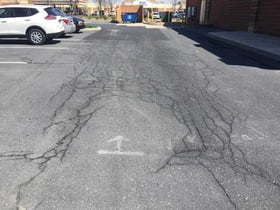What is the right scope of work for your property’s pavement? Can you get by with just repairs to the worst, isolated areas? Or would your money be better spent milling the existing surface and getting 10-15 years out of the lot? To mill or not to mill, that is the question.
Repairing Isolated Areas
Repairing isolated areas is the best solution for when less than 25% of the parking lot surface has failed or is presenting liability issues. These areas would be cut square, excavated, and repaved. This is a great scope for situations of isolated concern or high-traffic / high-visibility areas that need the aesthetics improved, but keep in mind that chasing isolated areas year-over-year could result in sinking money into a pavement condition that requires a more long-term perspective. When your parking lot is seeing more than 25% of failed areas, it would be more cost-effective to look at milling/paving vs. a larger expense hit to this year’s P&L. Click here to learn more about Paving Repairs.
| Isolated areas like these are perfect candidates for Paving Repairs. | Isolated areas like these are perfect candidates for Paving Repairs. |
Milling & Paving
If you’ve determined that your parking lot has areas of concern or failure beyond 25% of the total square footage, it’s time to think beyond just isolating repairs and more about the total costs over the next few years. Milling is a scope where the top, existing asphalt layer is scarified or ground off and then a new asphalt surface is installed.
This is a great scope for situations where the pavement concerns are mostly cracking and not necessarily deep base issues. The unit cost of milling/paving is a fraction of the repair scope and, in many cases, the cost can be capitalized. This scope will result in a brand-new surface and 10-15 years of life added to the pavement. Click here to learn more about Milling and Paving.
| Tightly held cracking (aka “alligatoring”) is also a condition where Milling is the most effective repair, if the area expands beyond 25% of the lot. |
 Areas of significant cracking but not significant “waviness” are situations where Milling is the most cost-effective scope.
Areas of significant cracking but not significant “waviness” are situations where Milling is the most cost-effective scope.
| Tightly held cracking (aka “alligatoring”) is also a condition where Milling is the most effective repair, if the area expands beyond 25% of the lot. |
Beyond Milling … Full-Depth Reclamation
In certain cases, where deep base issues are showing, full-depth reclamation is necessary to ensure the underlying problems are addressed. Full-depth issues present themselves as deep waviness on a parking lot or significant grade issues and puddling.
This scope involves grinding the entire existing asphalt down to a depth of around 12″, creating new base material with the ground-up, existing asphalt. That material is then graded and compacted to form a very structurally sound base for the new asphalt. New asphalt is then installed in two “lifts” (or courses) to provide a 30+ year life expectancy.
All-in-all, it’s important to determine what your pavement needs with the perspective of both hitting all the isolated liability areas and also considering how much of the overall pavement area needs repair. Once we reach the 25% of total square feet threshold, the economics begin to shift to scope that is less expensive on a unit cost basis but addresses your concerns for years to come.
| When many area of the lot display significant cracking, Milling is the most cost-effective approach and provides 10-15 year life expectancy. | When cracking is left unattended, failed areas become deep sub-base concerns that must be addressed with Full-Depth Reclamation. |




